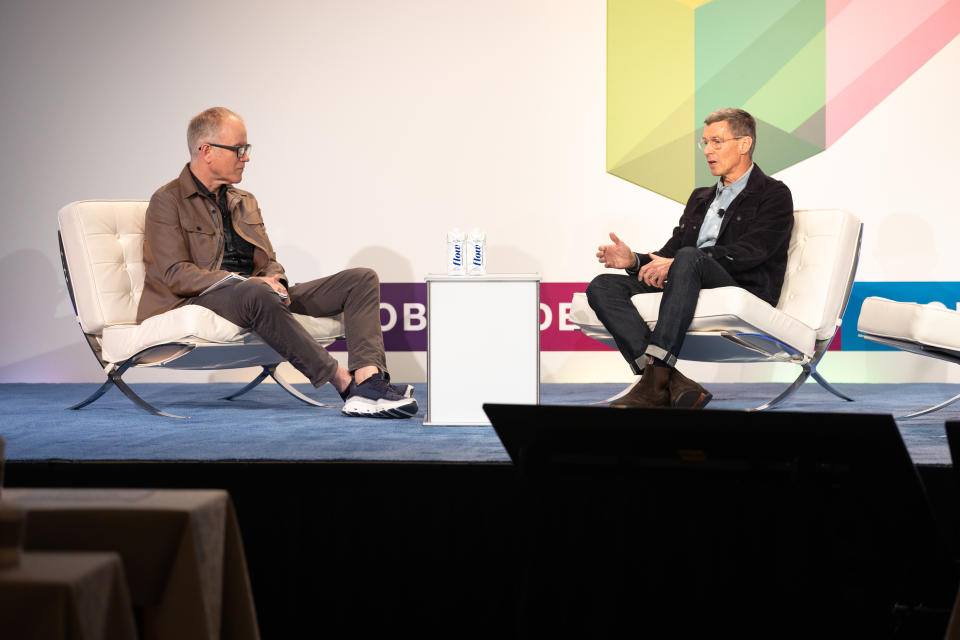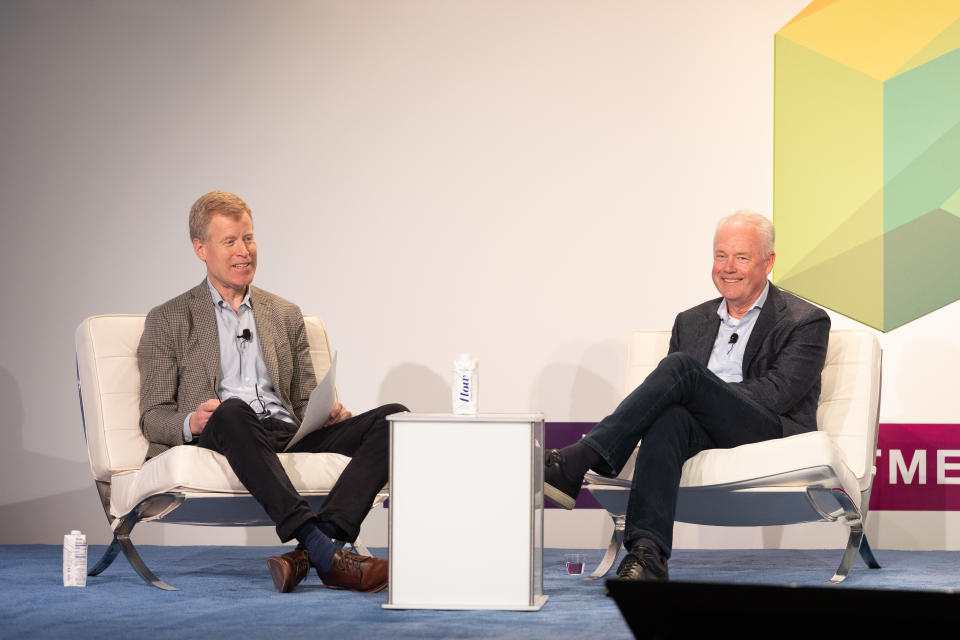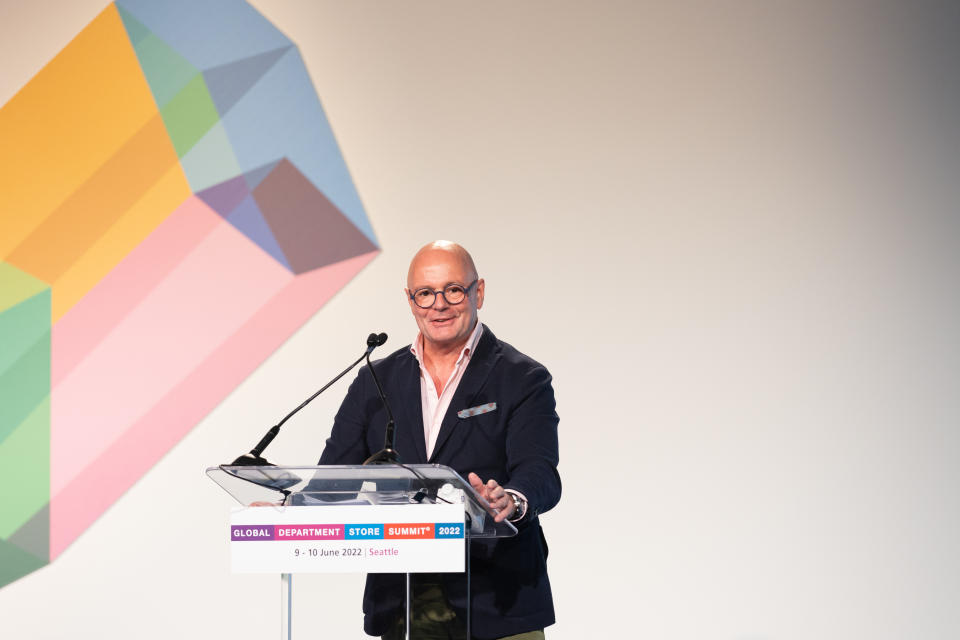Sizing Up Department Stores and the Survival Instinct

Department stores are fewer in number, still downsizing, but not extinct.
Coming off of recent restructurings, heady digital growth, channel integrations and a lot of introspection, the sector has turned a corner, and around the world department stores — from Macy’s and Nordstrom in the U.S., to Germany’s Galeria and Rustan’s in the Philippines — are in varying degrees of transformation.
More from WWD
A retail sector that’s resilient and getting progressive came across at the Global Department Store Summit, organized by the Intercontinental Group of Department Stores, this month, where presentations and conversations centered on ESG, redefining the workplace, reinvention and renewal, not recession. Retailers’ unwavering optimism was evident, leaving looming uncertainties for the near term more on the sidelines than center stage.
“It’s upbeat,” said Pete Nordstrom, the president and chief brand officer of Nordstrom Inc., when asked about the mood at the summit. “People are really appreciating being able to get together in person, in the same room. There is a sense of camaraderie. The world has become a smaller place. We are all sharing the same challenges and the same issues, whether it’s dealing with the supply chain or working on sustainability. Everyone is battle-tested.”
“We’ve got members 400 years old, 100 years old. How these businesses have survived and recreated themselves is what this conference is all about,” said Andre Maeder, IGDS president and chief executive officer of the KaDeWe Group in Germany.


During the two-day event, hosted by Nordstrom Inc. at the Sheraton Grand in downtown Seattle, while content-rich, the “R” word never surfaced, at least on stage. Why not go there?
“Look, retailers just went through the biggest recession,” explained Simon Susman, honorary president of Woolworth Holdings in South Africa, referring to two years of COVID-19. “They had ongoing rental payments. They were managing bank debt. They were giving out salaries in most cases. They are indeed battle-hardened.”
Susman’s point: retailers are better equipped now to deal with another possible recession than two years ago, and are feeling the moment, with the pandemic on the wane and shoppers returning to stores to replenish their wardrobes. So why not take in the best practices as told by the summit speakers?
“For the last 25 years, the messaging has been department stores are dead, but everyone that is here has survived,” Susman said. “If you are true to what you stand for, invest in your business, make it magical, and think of how you can make the world better, then customers will love to come to your stores.”
“This was a reasonably happy crowd telling us that things are pretty good. I liked the upbeat tempo but I think they were being myopic,” said Shah Karim, CEO of SafeRock, a consulting and technology firm, presenting a different perspective. “Pocketbooks are getting hit hard. Consumers have less discretionary spending. Financial realities were hidden behind the conversations, which were positive. Because of performances of the last year or two, you can effectively paint a very rosy picture now, but the truth isn’t really matching up. Of course, my interest [as a strategic adviser] is to understand who is in trouble. But there was some very good content presented at the conference.”

The event, held June 9 and 10, was themed “Retailing From the Outside-In” and drew some 250 leaders and senior officials from department stores, brands, suppliers and service companies. For its “Toys for Toys” program, Paris in Chile was awarded “the world’s best sustainability/corporate social responsibility campaign” by a department store last year. The annual IGDS summit was not held in 2021 or 2020 due to the pandemic.
Among the key takeaways from the event:
Department stores have a future; perceptions of being “dinosaurs” are passé.
Environmental, social and governance is good for business; retailers and brands must simplify the language of ESG so it’s less technical and consumers can readily understand goals and accomplishments.
In a data and digitally driven world, retail is still about providing experiences.
Companies are grappling with how to remake the workplace with a balance of office and remote situations to attract and retain talent and get the most productivity out of the workforce.
The Workforce and the Workplace
“Millennials and Gen Zers expect to have a voice at the table. They want to bring their ideas and energies to a project without being asked,” said Pete Shimer, chief operating officer of Deloitte USA, discussing leadership. “For them, leadership is about influence rather than authority.
“Sometimes we view the younger generation as being entitled. I don’t. It’s about creating enthusiasm and a sense of ownership that ought to be embraced. The war for talent is real. Two-thirds of Millennials and Gen Z say they will not take a job unless there is a corporate responsibility program.
“The chief purpose officer is going to be the next C-suite role,” Shimer said. “C-suite executives very much believe companies that pursue purpose beyond profit are more successful than those that pursue profit alone.”
Regarding shifts on where employees work from, accelerated by COVID-19, “It’s all about creating the right flexibility and right balance. We did a survey of our employees. Seventy-five percent really wanted to have both an in-person and remote work experience, but one in five said in-person connections with colleagues are difficult to form in this awkward time determining what this hybrid means. I believe you are going to find a balance in the middle. Gen Z is the hardest generation to get back in the office but need it the most, but the best they will do is give you two days a week.”
“The labor shortage is growing, fueled by Boomer retirements,” said Leslie McNamara, managing director, specialty partners, Citi Retail Services USA. “Boomers were the greatest workforce. They invented things like the 80-hour work week. They invented madmen. They found their passion and joy through work. They believed in companies. Many are working into their 70s, saying it keeps them young, connected. Then COVID[-19] happened and they found out they could get their passion, or fulfillment, from places other than work.”
McNamara said 11 million jobs are open and one in three won’t be filled. “Millennials are three times more likely to leave a job than Boomers; retention strategies will be less effective and recruiting strategies are likely not fast enough,” he warned.
“A physical presence is part of the recipe that makes for good communications,” said Pete Nordstrom. “We are trying to find that balance. It’s not going back to what it was. People have different needs and we want to be responsive to that. We have to be explicit about expectations so people can plan their lives.”
“We are all trying to figure it out. It’s arguably one of the great social experiments of our time,” said Levi Strauss president and CEO Chip Bergh.
Reinventing the Store
“Stores need to be more relevant,” said Stephen Spencer from John Lewis Partnership in the U.K., who holds the unusual title of director for the store of the future. John Lewis has embarked on a five-year overhaul calling for new financial targets, remaking the mix, simplifying the customer journey, better way-finding, and “joyful storytelling and immersive product experiences,” said Spencer. “We’ve got one million skus and an operating model that is dated.” The company generates 10.5 billion pounds in annual turnover, runs 36 department stores, 340 supermarkets, four main distribution centers and 26 local distribution centers, as well as farms, hotels and golf courses. For the department stores, Spencer stressed “the importance of not having one size fits all, local relevancy and changing the typical layout.”
“What makes a place an attraction, an experience? Sometimes it’s just mystical, mystery, just creating art,” said architect Kevin Roche, who worked on the redesign of the LVMH Moët Hennessy Louis Vuitton-owned La Samaritaine department store in Paris, where he had the luxury of reporting directly to the board and chairman Bernard Arnault instead of real estate or operations. “It was the pinnacle of my career to be recognized that design is a key strategic asset.…Trying things that are the unexpected comes from design thinking. You may not get the ROI [return on investment] as high but you get a more interesting experience. PricewaterhouseCoopers believes it’s time to introduce another metric, a focus on the consumer experience.”
For inspiration in recreating Samaritaine, “We examined hospitality, not other department stores. Seldom breakthroughs come from watching each other. The beauty category is where department stores can be really exciting and break away.”
“Customer service has been our North Star since the beginning,” said Jamie Nordstrom, chief stores officer of Nordstrom Inc. “The trick is to keep it simple, continuing to find ways to make service simple. Convenience is a big part of it. Convenience is a luxury. Service in the future depends on how digital and stores make each other better. A liberal return policy in my mind is the single best selling tool.”
“Department stores are very important points of distribution, even though they represent less than 20 percent of our global business,” said Pierre-Yves Roussel, CEO of Tory Burch. “The beauty of the department store is that it offers a customer a multibrand environment. We have a significant database on how customers that shop online and in the store spend three to four times more than a single channel customer.…At the same time we think it is very important to preserve the one brand concept. This has not been the way most fashion brands have operated, especially in department stores,” opting instead to have diffusion lines and licensing agreements. “In my experience that’s not a winning formula. It creates confusion, complexity and cost.”

“Rustan’s needs to become transformative, whatever changes we make must be connected to our roots. If they’re not, it’s easy to get lost,” said Bienvenido Tantoco 3rd, president of the 70-year-old, family-run Rustan Commercial Corp., which operates five department stores in the Philippines.
While Rustan’s is the leading upscale retailer in the Philippines, it’s not sufficiently resonating with the younger generation, Tantoco said. “Internal change has been slower than external change. COVID[-19] was an awakening. In this new retail Darwinism, caterpillars will die, and butterflies will fly. We’ve been snapped out of a certain sense of complacency.”
The Rustan’s flagship in Manila is being transformed in six phases over five years, with an Italian mosaic facade, a modern beauty hall, a gastronomic gallery of fresh and local ingredients for cooking, art installations, interactive experiences, a Filipino bakery, and a large landscaped sanctuary with an organic sequence of pathways, steps and decks, a grand archway, a shopping arcade, a nursery and a courtyard with a café by a lake. “We want it to be globally competitive, but a very Filipino experience,” Tantoco said. “In this Darwinistic uncertain world, we don’t know what is in store for us but we know what our mission is.”
At Galeria in Germany, which operates 131 department stores as a result of the merger of the Kartstadt and Kaufhof department stores, “We are going through heavy transformation. These two companies haven’t been profitable,” said Miguel Mullenbach, CEO of Galeria. “We still have 131 locations but we are not connected. It’s more about creating emotions and experiences than selling goods. The customer for department stores is dying. We have to rejuvenate the customer base. They’re coming in to buy beauty products, but they don’t go to the fashion department. Is there change needed in the assortment? The answer is yes. We are trading up and trending up in our assortment, to regain fashion expertise to better exploit existing customers and gain new customers.”
With Kaufhof and Karstadt, “The next step is to create a new brand, the new Galeria brand. It’s a hard discussion to get out of Karstadt and Kaufhof,” Mullenbach said. “We think the new Galeria logo can become an icon in terms of a popular brand. We believe in one strong brand across channels. So far, four units have been renamed just Galeria.”
Mullenbach said operating 131 department stores is a lot for Germany. “Years ago we had 250, maybe it will be 100 someday or 80….We have to reduce floor space to increase productivity….The main issue is there is no apparent culture because we merged from two companies. These two companies have to create one company culture, and not lose our heritage.” After his presentation, he told WWD, “Ninety percent of the business was lost during 10 months of COVID[-19]. We are not profitable.”
ESG
“If you are managing your company well, you have strong relations with suppliers and you are managing out waste, the business case is there,” said Cara Smyth, founder of the Responsible Business Coalition at Fordham University, of ESG. Buying power can force a lot of change, she said.
“We have 400 weeks before irreversible climate change is upon us in 2030. Within those 400 weeks we have a big responsibility and a big opportunity…The SEC is now asking for data on how climate change is affecting your business, and how is your business affecting climate change. The government says it’s material. Rules and regulations are changing quickly between 2024 and 2025. There will be real product information required.” A balance of providing understandable, concrete information to consumers without making it into a science list is required, she said. “The time is now to ask, ‘is my ESG data under control?’ The good news is we are all in it together, in getting done what has to be done.”
According to Smyth, while consumers are increasingly searching online for sustainable products, 44 percent feel companies make it easy for them to connect to sustainable or ethical initiatives.
“Everyone we interact with all talk about sustainability. But what does that mean? There are a zillion measurements. How can we define it more universally?” asked Pete Nordstrom.
“Sustainability is becoming a core brand attribute, requiring that we deliver meaningful impact on our footprint and tangible consumer-facing initiatives,” said Noel Kinder, chief sustainability officer at Nike Inc. “Ninety-two percent of Gen Z care about social and environmental issues; 82 percent say they’re worried about the health of the planet.”
He outlined Nike’s sustainability programs, including enabling consumers to donate shoes for recycling into other products, providing reusable bags as well as paper bags, providing no-rush shipments for a lower carbon footprint, simplifying packaging so there’s one box for both shipping and returns, and selling singlets made from recycled polyester. “Today, we are the biggest single user of recycled polyester in the industry,” Kinder said. “For 30 years sustainability has been part of Nike’s DNA.”
“Businesses exist more than just to earn a buck for a shareholder. They exist to make a difference in the world,” said Levi’s Bergh. Levi Strauss, the man himself, “the very first year he made a profit he donated a percentage to a local charity.”
The company has prioritized fighting gun violence and supports “putting common sense laws that almost all Americans support, like national background checks, red-flag laws, age restrictions on automatic weapons. What is happening is ripping the country apart,” said Bergh. In a polarized society, taking a stand on an issue makes the job of a CEO very difficult, Bergh said. “What got us into the whole gun issue was in 2016. A person in a fitting room shot himself in his foot. It could have been an employee, a customer, or a customer’s child,” said Bergh. “There are many states where a person can carry a weapon openly.”
Levi’s also takes on climate change. “If you say, let’s go solve this problem, it forces focus and discipline around the innovation process,” Bergh said. “The apparel industry is not necessarily a good guy when it comes to planet Earth. We need to double down when it comes to climate change. The important thing is consistency in how you talk about values and how you show up as a brand…..We like to say when we lead, others follow. We like to believe CEOs can make a difference.”
Kevin Johnson, special consultant and former CEO of Starbucks USA, advised, “Companies must think about their purpose in a way that goes beyond the pursuit of profit. Start with your employees, think about your customers you are serving, the community you serve. It’s capitalism taking a much broader view than driving the next quarterly results for Wall Street.
“We are starting to see investors, TPG, BlackRock, expect more from companies,” said Johnson. “Starbucks is a profit-positive company, but you can also be planet positive and a people positive company.” He said the company set three fundamental priorities during the pandemic — the health and well-being of Starbucks employees, partnering with health officials and “showing up in a positive way in every community we serve.” Starbucks drive-throughs were kept opened at a time when the Starbucks stores were temporarily closed. “We paid all of our partners whether they came to work or not. We gave them economic certainty.”
On Data
“We have been partnering with retailers on data-driven transformations,” said Shelley Branstein, corporate vice president at Microsoft USA. “Most department stores are only set up to leverage a fraction of the data.”
But there’s Walgreens, which has been “really thinking about data to improve the customer experience.” The pharmacy chain created a walk-through app so shoppers can save time looking for what they want, and works on having the right product in the right location. “Our cloud delivers 200 million predictions of what needs to be in every one of their stores every single day,” said Branstein. With Walgreens pharmacists becoming more critical through the pandemic, the chain developed the “intelligent pharmacists data platform” providing more information on those getting prescriptions and how often they come in, thereby “reducing the operational load and elevating customer engagements,” Branstein said.
She also commended Marks & Spencer. “They lowered the boundaries between the top floor and the bottom floor,” so to speak, by creating an app for CEOs to get direct feedback from store associates on what’s working or not working.
Ken Worzel, Nordstrom’s chief customer officer, said the company uses data in logistics to speed up deliveries and lower delivery costs by finding the best routes and place inventory where the demand is. Nordstrom has an “outfitter” technology utilizing data analytics on products and customers to generate outfitting advice. “We can do it at scale, rather than doing it manually for every customer. Customers don’t know whether it’s generated by stylists or through the algorithm. It generates outfits relevant across a vast set of occasions. Style boards are sent to customers. It’s been live for the last couple of years. We will continue to iterate on this. What’s next for us? Bringing in more context around product.”
Sign up for WWD's Newsletter. For the latest news, follow us on Twitter, Facebook, and Instagram.

